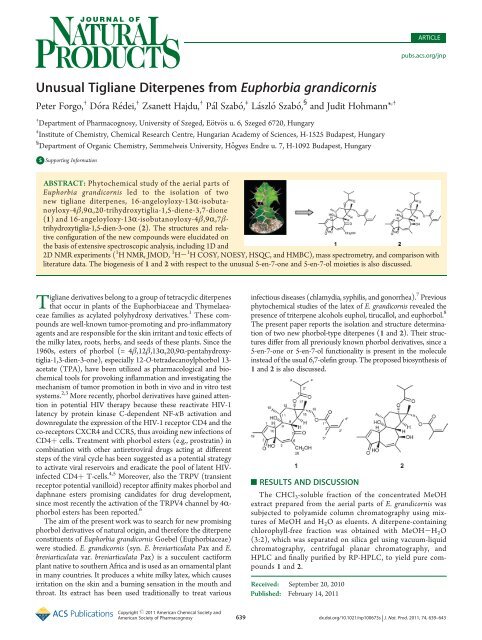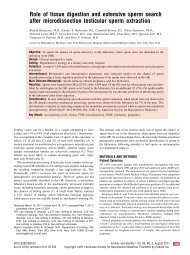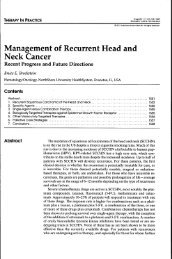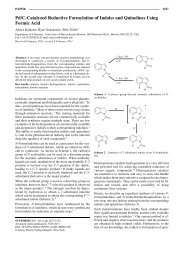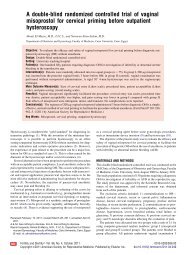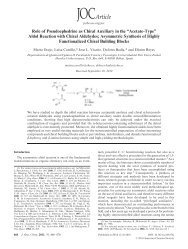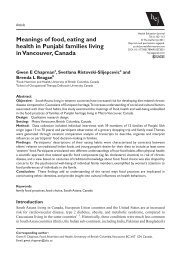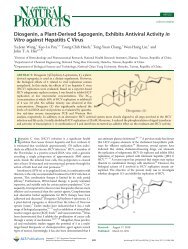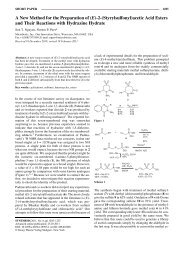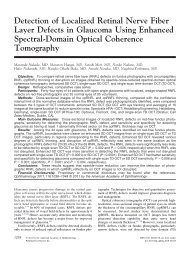Unusual Tigliane Diterpenes from Euphorbia grandicornis
Unusual Tigliane Diterpenes from Euphorbia grandicornis
Unusual Tigliane Diterpenes from Euphorbia grandicornis
Create successful ePaper yourself
Turn your PDF publications into a flip-book with our unique Google optimized e-Paper software.
<strong>Unusual</strong> <strong>Tigliane</strong> <strong>Diterpenes</strong> <strong>from</strong> <strong>Euphorbia</strong> <strong>grandicornis</strong><br />
Peter Forgo, † Dora Redei, † Zsanett Hajdu, † Pal Szabo, ‡ Laszlo Szabo, § and Judit Hohmann* ,†<br />
† Department of Pharmacognosy, University of Szeged, E€otv€os u. 6, Szeged 6720, Hungary<br />
‡ Institute of Chemistry, Chemical Research Centre, Hungarian Academy of Sciences, H-1525 Budapest, Hungary<br />
§ Department of Organic Chemistry, Semmelweis University, H 00 ogyes Endre u. 7, H-1092 Budapest, Hungary<br />
bS Supporting Information<br />
Received: September 20, 2010<br />
Published: February 14, 2011<br />
ARTICLE<br />
pubs.acs.org/jnp<br />
ABSTRACT: Phytochemical study of the aerial parts of<br />
<strong>Euphorbia</strong> <strong>grandicornis</strong> led to the isolation of two<br />
new tigliane diterpenes, 16-angeloyloxy-13R-isobutanoyloxy-4β,9R,20-trihydroxytiglia-1,5-diene-3,7-dione<br />
(1) and 16-angeloyloxy-13R-isobutanoyloxy-4β,9R,7βtrihydroxytiglia-1,5-dien-3-one<br />
(2). The structures and relative<br />
configuration of the new compounds were elucidated on<br />
the basis of extensive spectroscopic analysis, including 1D and<br />
2D NMR experiments ( 1 H NMR, JMOD, 1 H- 1 H COSY, NOESY, HSQC, and HMBC), mass spectrometry, and comparison with<br />
literature data. The biogenesis of 1 and 2 with respect to the unusual 5-en-7-one and 5-en-7-ol moieties is also discussed.<br />
<strong>Tigliane</strong> derivatives belong to a group of tetracyclic diterpenes<br />
that occur in plants of the <strong>Euphorbia</strong>ceae and Thymelaeaceae<br />
families as acylated polyhydroxy derivatives. 1 These compounds<br />
are well-known tumor-promoting and pro-inflammatory<br />
agents and are responsible for the skin irritant and toxic effects of<br />
the milky latex, roots, herbs, and seeds of these plants. Since the<br />
1960s, esters of phorbol (= 4β,12β,13R,20,9R-pentahydroxytiglia-1,3-dien-3-one),<br />
especially 12-O-tetradecanoylphorbol 13acetate<br />
(TPA), have been utilized as pharmacological and biochemical<br />
tools for provoking inflammation and investigating the<br />
mechanism of tumor promotion in both in vivo and in vitro test<br />
systems. 2,3 More recently, phorbol derivatives have gained attention<br />
in potential HIV therapy because these reactivate HIV-1<br />
latency by protein kinase C-dependent NF-κB activation and<br />
downregulate the expression of the HIV-1 receptor CD4 and the<br />
co-receptors CXCR4 and CCR5, thus avoiding new infections of<br />
CD4þ cells. Treatment with phorbol esters (e.g., prostratin) in<br />
combination with other antiretroviral drugs acting at different<br />
steps of the viral cycle has been suggested as a potential strategy<br />
to activate viral reservoirs and eradicate the pool of latent HIVinfected<br />
CD4þ T-cells. 4,5 Moreover, also the TRPV (transient<br />
receptor potential vanilloid) receptor affinity makes phorbol and<br />
daphnane esters promising candidates for drug development,<br />
since most recently the activation of the TRPV4 channel by 4Rphorbol<br />
esters has been reported. 6<br />
The aim of the present work was to search for new promising<br />
phorbol derivatives of natural origin, and therefore the diterpene<br />
constituents of <strong>Euphorbia</strong> <strong>grandicornis</strong> Goebel (<strong>Euphorbia</strong>ceae)<br />
were studied. E. <strong>grandicornis</strong> (syn. E. breviarticulata Pax and E.<br />
breviarticulata var. breviarticulata Pax) is a succulent cactiform<br />
plant native to southern Africa and is used as an ornamental plant<br />
in many countries. It produces a white milky latex, which causes<br />
irritation on the skin and a burning sensation in the mouth and<br />
throat. Its extract has been used traditionally to treat various<br />
infectious diseases (chlamydia, syphilis, and gonorrhea). 7 Previous<br />
phytochemical studies of the latex of E. <strong>grandicornis</strong> revealed the<br />
presence of triterpene alcohols euphol, tirucallol, and euphorbol. 8<br />
The present paper reports the isolation and structure determination<br />
of two new phorbol-type diterpenes (1 and 2). Their structures<br />
differ <strong>from</strong> all previously known phorbol derivatives, since a<br />
5-en-7-one or 5-en-7-ol functionality is present in the molecule<br />
instead of the usual 6,7-olefin group. The proposed biosynthesis of<br />
1 and 2 is also discussed.<br />
’ RESULTS AND DISCUSSION<br />
The CHCl 3-soluble fraction of the concentrated MeOH<br />
extract prepared <strong>from</strong> the aerial parts of E. <strong>grandicornis</strong> was<br />
subjected to polyamide column chromatography using mixtures<br />
of MeOH and H 2O as eluents. A diterpene-containing<br />
chlorophyll-free fraction was obtained with MeOH-H2O<br />
(3:2), which was separated on silica gel using vacuum-liquid<br />
chromatography, centrifugal planar chromatography, and<br />
HPLC and finally purified by RP-HPLC, to yield pure compounds<br />
1 and 2.<br />
Copyright r 2011 American Chemical Society and<br />
American Society of Pharmacognosy 639 dx.doi.org/10.1021/np100673s | J. Nat. Prod. 2011, 74, 639–643
Journal of Natural Products ARTICLE<br />
Table 1. NMR Data of Compounds 1 and 2 [500 MHz ( 1 H),<br />
125 MHz ( 13 C), CDCl 3, δ (ppm) (J = Hz)]<br />
position<br />
1 H<br />
1 2<br />
1 7.65 s 159.9 7.58 s 159.7<br />
2 134.8 133.9<br />
3 204.8 206.9<br />
4 72.8 71.9<br />
5 6.90 s 137.3 6.04 s 126.8<br />
6 147.9 150.0<br />
7 201.4 4.65 d (9.4) 83.1<br />
8 3.53 d (5.5) 54.6 2.60 dd (9.4, 5.4) 45.6<br />
9 73.2 72.6<br />
10 3.32 brs 58.6 3.07 s 56.7<br />
11 2.08 m 38.2 2.08 m 37.8<br />
12β 2.10 m 31.5 2.18 dd (11.8, 4.3) 31.5<br />
12R 1.62 dd (14.0, 11.0) 1.60 dd (14.9, 11.8)<br />
13 62.7 63.3<br />
14 1.95 d (5.5) 20.8 1.71 d (5.5) 27.0<br />
15 25.8 25.4<br />
16a 4.17 d (11.5) 69.0 4.51 d (11.3) 70.3<br />
16b 4.07 d (11.5) 3.99 d (11.3)<br />
17 1.16 s 11.1 1.13 s 11.2<br />
18 0.96 d (6.4) 18.5 0.94 d (6.5) 18.5<br />
19 1.83 d (1.5) 10.0 1.80 d (1.4) 9.8<br />
20a 4.37 d (14.2) 63.7 2.04 s 22.3<br />
20b<br />
isobutanoyl<br />
4.25 d (14.2)<br />
10 178.8 178.8<br />
20 2.54 sept (7.0) 34.2 2.56 sept (7.0) 34.0<br />
30 1.15 d (7.0) 18.5 1.13 d (7.0) 18.5<br />
40 angeloyl<br />
1.15 d (7.0) 18.5 1.14 d (7.0) 18.5<br />
100 167.7 168.0<br />
200 127.5 127.0<br />
300 6.09 q (7.3) 137.8 6.08 q (7.2) 139.0<br />
400 1.97 dd (7.3, 1.5) 15.8 1.96 dd (7.2, 1.1) 15.7<br />
500 1.88 s 20.4 1.87 s 20.0<br />
OH-4 2.67 s 2.23 s<br />
OH-7 8.52 s<br />
OH-9 6.09 s 5.73 s<br />
OH-20 2.37 s<br />
Compound 1 was isolated as a colorless, amorphous solid. Its<br />
positive ion ESIMS displayed a quasimolecular ion peak at m/z<br />
553 [M þ Na] þ , indicating a molecular mass of 530, corresponding<br />
to the formula C29H38O9, which was supported by HR-<br />
ESIMS (m/z 553.2425, calcd for 553.2408, C 29H 38O 9Na). The<br />
1 H and JMOD NMR spectra exhibited typical resonances for<br />
isobutyrate [δH 2.54 sept (1H), 1.15 d (6H); δC 178.8, 34.2, 2<br />
18.5] and angelate [δ H 6.09 q (1H), 1.97 dd (3H), 1.88 s (3H);<br />
δC 167.7, 137.8, 127.5, 15.8, 20.4] ester groups (Table 1). In<br />
addition, with the aid of the JMOD, 1 H- 1 H COSY, and HSQC<br />
spectra, eight quaternary carbons, six methines, three methylenes,<br />
and three methyl groups were detected, accounting for a<br />
20-carbon-containing diterpene skeleton. Analysis of the 1 H- 1 H<br />
COSY spectrum provided only a little more information on the<br />
13 C<br />
1 H<br />
13 C<br />
partial structures. Two isolated methylenes [δH 4.17 and 4.07 d<br />
(J = 11.5 Hz), 4.37 and 4.25 d (J = 14.2 Hz)] and the following<br />
short structural fragments were elucidated on the basis of the<br />
correlated proton sequences: CH3-CH-CH2- (unit A, δH<br />
0.96 d, 2.08 m, 2.10 m, and 1.62 dd), -CH-CH- (unit B, δ H<br />
3.53 and 1.95 d), and -CH-CHd (unit C, δH 3.32 brs and<br />
7.65 s). The carbon resonances at δC 201.4 and 204.8 demonstrated<br />
the presence of two keto groups in the molecule. Furthermore,<br />
two trisubstituted olefins were evident <strong>from</strong> the carbon<br />
resonances at δC 137.3, 147.9, 159.9, and 134.8 and the proton<br />
resonances at δH 7.65 and 6.90 s. One of these units, together with<br />
a methyl (C-19), a keto group (C-3), a methine (C-10), and a Osubstituted<br />
quaternary carbon (C-4), comprised a methylsubstituted<br />
five-membered ring, characteristic of 4-hydroxyphorbol<br />
esters, as proved by the HMBC correlations detected between<br />
H-19/C-1, H-19/C-2, and H-19/C-3. The other trisubstituted<br />
olefin was placed at positions C-5-C-6, since heteronuclear longrange<br />
correlations were detected between H-5 and C-10 and<br />
between H-5 and C-3 in the HMBC spectrum and allylic coupling<br />
between H-5 and H-20 in the 1 H- 1 H COSY spectrum. The<br />
quaternary carbon at δC 73.2 (C-9) showed two- and three-bond<br />
correlations to the protons of unit A [δ H, 2.08 m (H-11) and<br />
0.96 d (H-18)], suggesting that this structural fragment represents<br />
the C-18-C-11-C-12 part of a 9,13-substituted tigliane diterpene.<br />
The two methine groups containing unit B were assigned as<br />
the C-8-C-14 part of the molecule and confirmed <strong>from</strong> the<br />
HMBC correlations between H-8 and C-9, H-14 and C-13, H-14<br />
and C-15, and H-8 and C-15. The presence of a keto group (δ C<br />
201.4) at C-7 was concluded on the basis of the H-8/C-7 and<br />
H-14/C-7 long-range correlations, and the 16- and 20-methylenes<br />
were corroborated by the HMBC cross-peaks between H-5/C-20,<br />
H-16/C-15, H-16/C-17, and H-17/C-13. The position of the<br />
angeloyl group at C-16 was evident <strong>from</strong> the three-bond correlation<br />
between the ester carbonyl carbon (δC 167.7) and the H2-16<br />
protons (δ H 4.07 and 4.17 d). Hydroxy groups at C-9 and C-20<br />
were deduced <strong>from</strong> the NOESY correlation between the OH<br />
group (δH 6.09) and H-10 and H-12b and the 1 H- 1 HCOSY<br />
correlation between OH group (δ H 2.37) and H-20 protons,<br />
respectively. The location of the isobutanoyl group at C-13 was<br />
determined on the basis of the chemical shift value of C-13 (δC<br />
62.7 ppm), which was in the usual range of 13-acyl-substituted<br />
phorbol esters (δC 62.7-63.6 ppm). 9-11<br />
The relative stereochemistry of 1 was elucidated by analyzing<br />
the correlations detected in a NOESY spectrum (Figure 1). NOE<br />
interactions between H-8 and H-11, H-8 and H 3-17, H 3-17 and<br />
H-12β, and H-12β and H-11 indicated the β-position of all these<br />
protons and the methyl group. On the other hand, NOESY crosspeaks<br />
between H-12R and OH-9, OH-9, and H-10; H-10 and<br />
H-1; H-1 and H-18,; and H-16a,b and H-14 dictated an Rarrangement<br />
of H-10, OH-9, H-14, and the C-16-methylene and<br />
C-18-methyl groups. The trans A/B ring junction with H-10R<br />
and OH-4β and the 13-acyl group in an R-position were<br />
concluded on the basis of biogenetic considerations, since all<br />
phorbol-type diterpenes isolated so far have such functionalities<br />
and because the C-4, C-10, and C-13 chemical shift values of 1<br />
were in good agreement with those of structurally related<br />
compounds. 10,12,13 All of the above data were compatible with<br />
the structure of 1 being proposed as 16-angeloyloxy-13R-isobutanoyloxy-4β,9R,20-trihydroxytiglia-1,5-diene-3,7-dione.<br />
Compound 2 was isolated as a colorless oil. Its molecular<br />
formula was assigned as C 29H 40O 8 on the basis of the HRESIMS<br />
and NMR data. The 1 H NMR and J-modulated 13 C NMR<br />
640 dx.doi.org/10.1021/np100673s |J. Nat. Prod. 2011, 74, 639–643
Journal of Natural Products ARTICLE<br />
Figure 1. Key NOESY correlations for compound 1.<br />
spectra, analyzed with the aid of 1H-1H COSY, HSQC, and<br />
HMBC experiments, showed the same ester groups, one isobutyroyl<br />
and one angeloyl as in the case of 1 (Table 1). The<br />
diterpene core of 2 was found to be constructed by structural<br />
elements [-CH-CHdC(CH3)- (C-10-C-1-C-2-C-19)<br />
and CH 3-CH-CH 2- (C-18-C-11-C-12)] similar to those<br />
of 1, indicating the same tigliane skeleton, but in the case of 2<br />
only one keto group (δC 206.9) and one O-substituted methylene<br />
(δ H 4.51 d, 3.99 d, δ C 70.3) were detected. Moreover, an<br />
additional methyl (δH 2.04 s, δC 22.3) and an O-substituted sp 3<br />
methine group (δH 4.65 d, δC 83.1) were identified. The latter<br />
comprises part of the molecular fragment, -CH-CH-CH-,as<br />
demonstrated by the 1H-1H COSY correlations between δH<br />
4.65 (d, H-7), 2.60 (dd, H-8), and 1.71 (d, H-14). This structural<br />
element was deduced as the C-7-C-8-C-14 portion of the<br />
molecule with regard to the heteronuclear long-range correlations<br />
between H-14 and C-13, C-15, C-16, and C-17 and<br />
between H-8 and C-6 and C-15. A deshielded methyl signal<br />
(δ H 2.04 s) displayed HMBC correlations to C-5, C-6, and C-7<br />
and allylic coupling with H-5 and H-7 in the 1H-1H COSY<br />
spectrum, proving its assignment as C-20 and the presence of a<br />
5,6-double bond. The locations of the ester and hydroxy groups<br />
were determined with the aid of the 2D NMR spectra. The<br />
positions of the angeloyl group at C-16, isobutanoyl group at<br />
C-13, and hydroxy groups at C-4 and C-9 were indicated by the<br />
1 H and 13 C chemical shift values of 2, similar to those of 1, and by<br />
the HMBC and NOESY correlations. The position of a hydroxy<br />
group (δH 8.52 s) at C-7 in 2 was demonstrated by the 1H-1H<br />
COSY correlation between H-7 and OH-7.<br />
The relative configuration of the stereogenic centers in 2 was<br />
investigated on the basis of the NOESY spectrum. Starting <strong>from</strong><br />
the H-10R stereochemistry, the R-orientation of H-7, H-14, C-16methylene,<br />
H-18, and OH-9 was concluded, since NOEs were<br />
observed between H-10 and H-7, H-7 and H-14, H-14 and H-16,<br />
H-12b and H-18, and H-14 and OH-9. On the other hand, the<br />
NOESY correlations between H-11 and H-8, H-11 and H3-17,<br />
H3-17 and H-8, and H-12a and H-11 pointed to these β-oriented<br />
protons and a methyl group. All of the above evidence was used to<br />
propose the structure of compound 2 as 16-angeloyloxy-13Risobutanoyloxy-4β,9R,7β-trihydroxytiglia-1,5-dien-3-one.<br />
Compounds 1 and 2 have unusual structural features with<br />
regard to the presence of the 5-en-7-one and 5-en-7-ol substituents.<br />
Biogenetically, these structural moieties may be formed as<br />
presented in Figure 2. At first sight, it would be obvious to<br />
introduce simultaneously two hydroxy groups at C-4 and C-7,<br />
respectively, by a double allylic oxidation. However, no example is<br />
known for an allylic oxidation that would run on a saturated carbon<br />
atom attached to a carbonyl group. Therefore, a roundabout way is<br />
preferred, in which all steps are known in the preparative organic<br />
chemistry and in the chemistry of natural products. 14,15 In the<br />
majority of the tigliane derivatives, C-4 has a similar hydroxy<br />
group, which might be introduced in the same manner. In the first<br />
step, the biosynthetic precursor tiglia-2,6,10-triene (3) isomerized<br />
to compound 4; then an epoxide group can be formed (5), which<br />
hydrolyzed by acid or base catalysis to the vicinal diol 6. Water<br />
elimination of 6 results in the formation of 7 and therewith the<br />
regeneration of the 5,6-olefin group. Allylic oxidation of 7 may<br />
afford the 7-hydroxy derivative (8), which represents the structural<br />
type of compound 2. Dehydrogenation of the 7-hydroxy to 7-keto<br />
group forms 9, the structural type of compound 1. In the structural<br />
formulas in Figure 2, additional oxygen functions were omitted, as<br />
their origin is not yet clear. It should be emphasized that this and<br />
similar schemes are based on analogies and chemotaxonomical<br />
facts, rather than experimental data.<br />
In conclusion, a phytochemical study of the aerial part of E.<br />
<strong>grandicornis</strong> afforded two unprecedented types of natural diterpenes<br />
of the tigliane class. The isolated compounds may have a<br />
valuable biological potential as protein kinase C activators and<br />
modulators of the TRPV4 receptor.<br />
’ EXPERIMENTAL SECTION<br />
General Experimental Procedures. Optical rotations were<br />
determined in chloroform by using a Perkin-Elmer 341 polarimeter.<br />
NMR spectra were recorded on a Bruker Avance DRX 500 spectrometer<br />
at 500 MHz ( 1 H) and 125 MHz ( 13 C) with TMS as internal standard.<br />
Two-dimensional data were acquired and processed with standard<br />
Bruker software. For 1 H- 1 H COSY, HSQC, and HMBC experiments,<br />
gradient-enhanced versions were used. Low-resolution ESI mass spectra<br />
were recorded on an Applied Biosystems 3200QTrap instrument. Samples<br />
were acquired in flow injection mode. High-resolution MS data were<br />
recorded on an Shimadzu IT-TOF mass spectrometer equipped with<br />
electrospray source. The resolution was over 10 000. Column chromatography<br />
was carried out on polyamide (50-160 μm, MP Biomedicals),<br />
and vacuum-liquid chromatography (VLC) on silica gel G (15 μm,<br />
Merck). Centrifugal planar chromatography (CPC) was carried out on<br />
silica gel 60 GF254 using a Chromatotron instrument (Harrison Research).<br />
Separations were monitored by TLC on Merck 60 F254 (0.25<br />
mm) plates and visualized by staining with concentrated sulfuric acid.<br />
Preparative thin layer chromatography was performed on silica gel 60 F254<br />
(Merck) and RP-18 F 254 plates (Merck). HPLC was performed on a<br />
Waters instrument with detection at 254 nm on a LiChrospher RP-18<br />
(5 μm, 250 4 mm, Merck) column using MeOH-H 2O (4:1) as mobile<br />
phase at 0.5 mL/min flow rate and on a LiChrospher Si 100 (5 μm, 250<br />
4 mm, Merck) column with cyclohexane-EtOAc-EtOH (140:40:1) at<br />
0.5 mL/min flow.<br />
Plant Material. The aerial parts of E. <strong>grandicornis</strong> were cultivated as<br />
an ornamental plant in Szeged-Kecskes, Hungary, in March 2008. The<br />
plant was identified by one of the authors (Z.H.). A voucher specimen<br />
(No. 769) has been preserved in the Herbarium of the Department of<br />
Pharmacognosy, University of Szeged, Szeged, Hungary.<br />
Extraction and Isolation. The fresh plant material (10 kg) was<br />
crushed in a blender and then percolated with 38 L of MeOH at room<br />
temperature. The crude extract was concentrated in vacuo and extracted<br />
exhaustively with CHCl3 (5 500 mL). The organic phase (29.4 g) was<br />
chromatographed on a polyamide column (180 g) with mixtures of<br />
MeOH and H 2O (3:2 and 4:1, each 2000 mL) as eluents. The fraction<br />
(0.6 g) obtained with MeOH-H2O (3:2) was subjected to silica gel<br />
VLC using a gradient system of n-hexane-acetone (9:1, 8:2, 7:3, 6:4,<br />
1:1, and 3:7). Fractions with similar compositions according to TLC<br />
641 dx.doi.org/10.1021/np100673s |J. Nat. Prod. 2011, 74, 639–643
Journal of Natural Products ARTICLE<br />
Figure 2. Proposed biogenetic derivation of structural types of 1 and 2.<br />
monitoring were combined, affording fractions I-XI. Fraction V, obtained<br />
with n-hexane-acetone (7:3), was fractionated by CPC on silica gel, using<br />
n-hexane-acetone mixtures with refined gradient steps [19:1 (200 mL),<br />
9:1 (200 mL), 17:3 (200 mL), 8:2 (150 mL), 3:1 (150 mL), and 7:3<br />
(150 mL)]. Fraction (0.118 g), eluted with n-hexane-acetone (19:1 and<br />
9:1), was purified by preparative TLC using the developing system of nhexane-acetone<br />
(13:7). Band 3 (Rf = 0.4), detected at UV 254 nm, was<br />
further purified by RP-HPLC using MeOH-H2O (4:1) as mobile phase, to<br />
yield the pure compound 1 (1.8 mg). Fraction V, obtained with n-hexaneacetone<br />
(4:1) <strong>from</strong> the VLC separation, was purified first by normal-phase<br />
HPLC and finally by RP-HPLC to afford compound 2 (2.5 mg).<br />
16-Angeloyloxy-13R-isobutanoyloxy-4β,9R,20-trihydroxytiglia-1,5diene-3,7-dione<br />
(1):. colorless oil; [R] 25 D þ56 (c 0.05, CHCl 3); for 1 H<br />
NMR and 13 C NMR spectroscopic data, see Table 1; ESIMS m/z 553<br />
[M þ Na] þ , 569 [M þ K] þ , 548 [M þ NH4] þ ;HRESIMSm/z 553.2425<br />
[M þ Na] þ , calcd for 553.2414 C 29H 39O 8.<br />
16-Angeloyloxy-13R-isobutanoyloxy-4β,9R,7β-trihydroxytiglia-1,5dien-3-one<br />
(2):. colorless oil; [R] 25 D þ27 (c 0.05, CHCl3); for 1 H<br />
NMR and 13 C NMR spectroscopic data, see Table 1; HRESIMS m/z<br />
517.2649 [M þ H] þ , calcd for 517.2644 C 29H 41O 8, 537.2484 [M þ Na] þ<br />
calcd for 537.2464 C29H40O8Na.<br />
’ ASSOCIATED CONTENT<br />
b S Supporting Information. Copies of the 1D and 2D<br />
NMR spectra of compounds 1 and 2 are available free of charge<br />
via the Internet at http://pubs.acs.org.<br />
’ AUTHOR INFORMATION<br />
Corresponding Author<br />
*Tel: þ36 62 546 453. Fax: þ36 62 545 704. E-mail: hohmann@<br />
pharm.u-szeged.hu.<br />
’ ACKNOWLEDGMENT<br />
Financial support <strong>from</strong> the Hungarian Scientific Research<br />
Fund (grant OTKA PD78145) and the New Hungary Development<br />
Plan TAMOP-4.2.2-08/1-2008-0013 and TAMOP-<br />
4.2.1/B-09/1/KONV-2010-0005 is gratefully acknowledged.<br />
’ REFERENCES<br />
(1) Shi, Q. W.; Su, X. H.; Kiyota, H. Chem. Rev. 2008, 108, 4295–<br />
4327.<br />
(2) Hecker, E. Cancer Res. 1968, 28, 2338–2349.<br />
(3) Hecker, E. Pure Appl. Chem. 1977, 49, 1423–1431.<br />
(4) Avila, L.; Perez, M.; Sanchez-Duffhues, G.; Hernandez-Galan, R.;<br />
Munoz, E.; Cabezas, F.; Quinones, W.; Torres, F.; Echeverri, F.<br />
Phytochemistry 2010, 71, 243–248.<br />
(5) Marquez, N.; Calzado, M. A.; Sanchez-Duffhues, G.; Perez,<br />
M.; Minassi, A.; Pagani, A.; Appendino, G.; Diaz, L.; Munoz-<br />
Fernandez, M. A.; Munoz, E. Biochem. Pharmacol. 2008, 75, 1370–<br />
1380.<br />
(6) Klausen, T. K.; Pagani, A.; Minassi, A.; Ech-Chahad, A.; Prenen,<br />
J.; Owsianik, G.; Hoffmann, E. K.; Pedersen, S. F.; Appendino, G.; Nilius,<br />
B. J. Med. Chem. 2009, 52, 2933–2999.<br />
(7) Heine, B.; Brenzinger, M. Ethnobotanical Survey of the Semi-Arid<br />
and Arid Lands of East Africa, Part IV; Heine, B., Ed.; Fort Lauderdale<br />
Breitenbach: Saarbr€ucken, 1988; p 205.<br />
(8) Piozzi, F.; Wanda, K. Rend.-Ist. Lomb. Accad. Sci. Lett., B: Sci.<br />
Chim. Fis., Geol. Biol. Med. 2002, 136, 273–278.<br />
(9) Haba, H.; Lavaud, C.; Harkat, H.; Magid, A. A.; Marcourt, L.;<br />
Benkhaled, M. Phytochemistry 2007, 68, 1255–1260.<br />
(10) Wu, Q. C.; Tang, Y. P.; Ding, A. W.; You, F. Q.; Zhang, L.;<br />
Duan, J. A. Molecules 2009, 14, 4454–4475.<br />
(11) Sulyok, E.; Vasas, A.; Redei, D.; Dombi, G.; Hohmann, J.<br />
Tetrahedron 2009, 65, 4013–4016.<br />
642 dx.doi.org/10.1021/np100673s |J. Nat. Prod. 2011, 74, 639–643
Journal of Natural Products ARTICLE<br />
(12) Wang, Y. B.; Huang, R.; Wang, H. B.; Jin, H. Z.; Lou, L. G.; Qin,<br />
G. W. J. Nat. Prod. 2006, 69, 967–970.<br />
(13) Zhao, W.; Wolfender, J. L.; Mavi, S.; Hostettmann, K.<br />
Phytochemistry 1998, 48, 1173–1177.<br />
(14) Dewick, P. M. Nat. Prod. Rep. 2002, 19, 181–222.<br />
(15) Dewick, P. M. Nat. Prod. Rep. 1999, 16, 97–130.<br />
643 dx.doi.org/10.1021/np100673s |J. Nat. Prod. 2011, 74, 639–643


